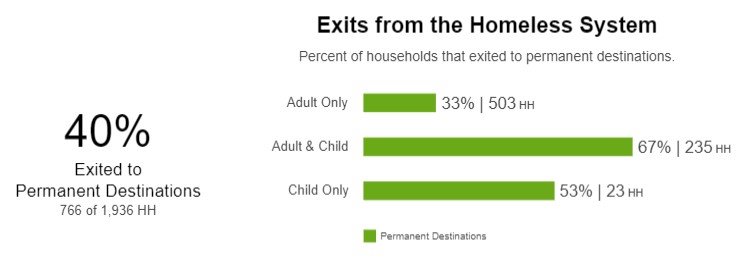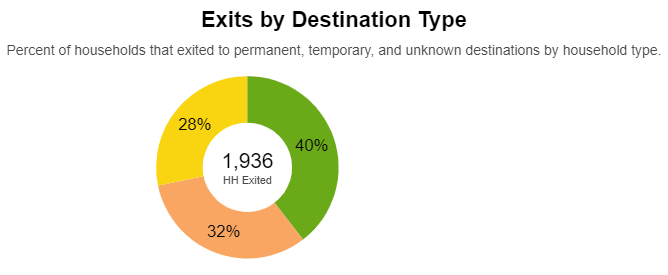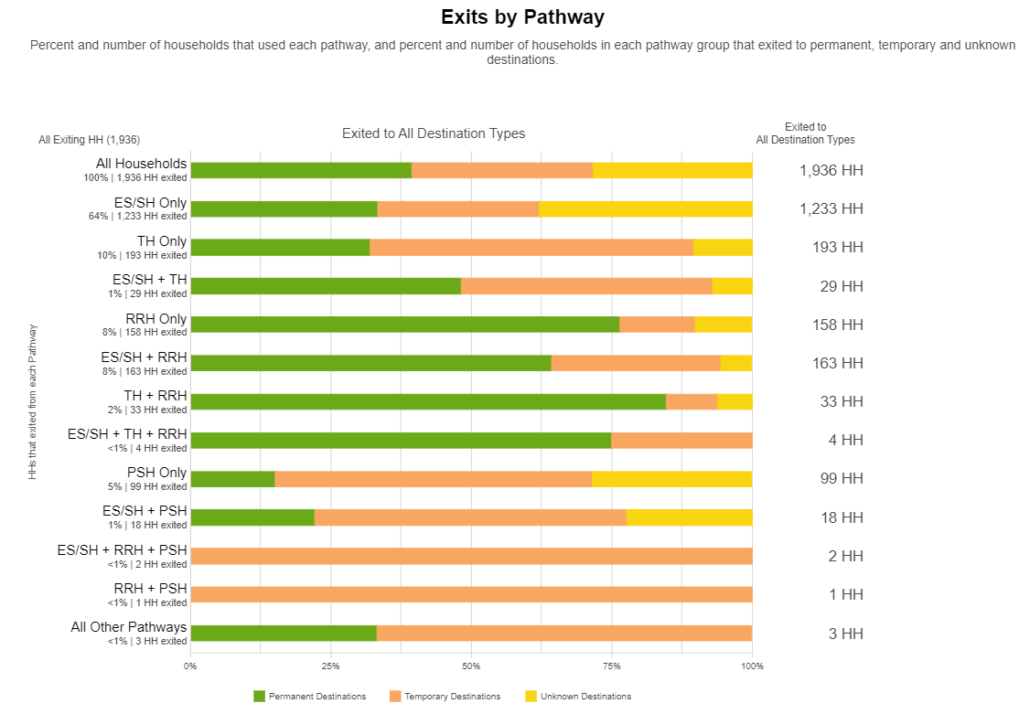Leveraging Stella P to Enhance Homeless Services Systems:
Increasing Permanent Exits from the Homeless Services System
Mary Ann Priester
Senior Management Analyst
Mecklenburg County Community Support Services
Stella, developed by the Department of Housing and Urban Development (HUD), serves as an analytical and strategic tool for Continuums of Care (CoCs) to examine the dynamics of their homeless services system performance. The Stella Performance Module (Stella P) visualizes a homeless system’s performance using the CoC’s Longitudinal System Analysis (LSA) data. Stella P empowers communities to develop and monitor strategies to improve system performance. This blog is the second installment in a series of blogs examining Charlotte-Mecklenburg’s latest LSA data utilizing the Stella P Module.
This blog provides an overview of system exits, local performance on this metric, and highlights opportunities for performance improvement within the Charlotte-Mecklenburg homeless services system.
STELLA P
Stella P is used to visualize a CoC’s Longitudinal System Analysis (LSA) data. It consists of five sections: Dashboard, Days Homeless, Exits, Returns, and Demographics.
Dashboard: Provides an overview of the number of households and people served and a performance overview; trends over the past 3 years; and a system performance map.
Days Homeless, Exits, Returns: Reviews system level performance for number of days homeless, permanent housing exits from the homeless system, and returns to homelessness after exits to a permanent destination. Each measure can be examined by pathway (combination of projects types a household uses when moving through the homelessness system), population group, and race and ethnicity.
Demographics: Provides an overview of demographic characteristics for households and individuals served by household type and project type and a comparison of demographic characteristics by project type.
A previous blog provided an overview of LSA data and the Stella P dashboard and system performance map. This blog focuses on system exits.
SYSTEM EXITS
The Stella P System Exits module consists of four components: Exits Overview, Exits by Pathway, Exits by Population, and Exits by Race and Ethnicity. This blog will examine the first three. A future blog will focus on how Stella P can be used to assess system performance by race and ethnicity.
The system exits metric is based on homeless system exits which are defined as the last exit from an HMIS participating project in the reporting period with no enrollment in another project type for at least 14 days following the exit. If a household enrolls in another project type within 14 days, the exit is considered a project exit but not a system exit because the household did not exit the homeless services system, they only exited a particular project. The household is not considered to have exited the system until they exit a project and do not enroll in another project prior to the 14-day cutoff. As long as a household remains enrolled in an emergency shelter, safe haven, transitional housing, or rapid rehousing or permanent supportive housing (even if housed) within the homeless services system, they are not considered to have exited the system.
The key performance metric for exits is exits to a permanent destination. Permanent destinations include exits to home ownership or rental with or without subsidy and staying with friends or family permanently. The system exits overview page shows an overview of permanent exits from the homeless services system by household type, exits by destination type, and trends in the number of exits to a permanent destination in the previous three years. The exits by pathway page shows exits by the combination of projects that a household is served in during their experience in the homeless services system. The exits by population group page shows the percentage of each population group and the percentages of each exit type by population. Both the exits by pathway and exits by population group pages can be used to drill down to specific household and exit destination types.
CHARLOTTE-MECKLENBURG SYSTEM EXITS
OVERVIEW
The Charlotte-Mecklenburg System Exits module shows that 40% of people who exited from the homeless services system within the reporting period, exited to a permanent destination. Thirty-three percent of adult only households exited to permanent destination, 67% of adult child households exited to permanent destinations, and 53% of child only households exited to permanent destinations. It is important to note that child-only households are typically served by the local youth shelter which often provides temporary shelter or respite care for children while their families work to access shelter or other accommodations. Thirty-two percent of households exited to temporary destinations which include emergency shelter, safe haven, transitional housing, institutions, staying temporarily with family or friends, and unsheltered destinations. Twenty-eight percent of households exited to unknown destinations. Unknown destinations include when a household does not know where they will be going post exit or they prefer not to share the information with the program they are exiting, when there is no program exit interview completed, or when the data is not collected and the exit field is missing a response. The majority of exits to unknown destinations were by adult only households.
BY PATHWAY
The exits by pathway chart shows that 64% of exits were from the emergency shelter/ safe haven only pathway; 10% were from transitional housing only; 8% were from rapid rehousing only; and 8% were from the emergency shelter/ safe haven + rapid rehousing pathway. The emergency shelter/ safe haven only pathway has a high rate of exits to unknown destinations (38%) compared to 28% for all pathways. We see the greatest number of permanent exits from the rapid rehousing only (77%) and the transitional housing + rapid rehousing (85%) pathways.
How to read the chart: The left side of the chart shows the pathway name and the number and percentage of households that exited the homeless services system. Green represents permanent destinations; orange represents temporary destinations; and yellow represents unknown destinations
BY POPULATION GROUP
The exits by population type chart shows that of the population types featured, adult child households with 3 or more children have the highest rate of exits to permanent destinations (68%). Thirty percent of households that were homeless for the first time exited to a permanent destination. When this same group is examined at the household level, 52% of adult child household that were homeless for the first time exited to permanent destinations while only 25% of adult only households that were homeless for the first time exited to a permanent destination. Both household types most frequently exited to permanently staying with family. Adult only households who were homeless for the first time (37%) and adult only households age 55 and older (31%) had the highest rate of exits to unknown destinations.
How to read the chart: The left side of the chart shows the population name and the number and percentage of households that exited the homeless services system. Green represents permanent destinations; orange represents temporary destinations; and yellow represents unknown destinations
OPPORTUNITIES FOR IMPROVEMENT
High rates of unknown destinations impact our ability to fully understand the outcomes of people who are moving through the homeless services system. Because of the high number of exits from the emergency shelter/ safe haven only pathway and the high rates of unknown destinations for this pathway, focusing on reducing the number of unknown exits from this pathway would have the greatest impact on this particular metric. Reducing the number of unknown exits in this pathway would not only improve overall performance on the system exits metric but would also facilitate a better understanding of the efficiency and effectiveness of the various pathways in supporting households on their journey to exit homelessness.
One way to decrease the number of unknown exits in the emergency shelter/ safe haven pathway may be to increase household engagement by increasing case management capacity within emergency shelter and safe haven programs. Effective case management in shelter settings is crucial for supporting individuals and families experiencing homelessness working toward housing stability. The ideal case manager to client ratio in emergency shelters can vary depending on factors such as the complexity of client needs, available resources, and funding constraints. Evaluating the individual needs of households accessing shelter is essential to developing case management service delivery models that are effective. Clients with more complex needs, such as those experiencing chronic homelessness, or households with mental health or substance use challenges, may require more intensive case management support. It is important to consider the needs of the households the shelter is serving when determining the size of caseloads that case managers can effectively manage while still providing high-quality, individualized support to households. Smaller caseloads may allow case managers to provide more comprehensive and intensive services to each client. Right-sized staffing levels can facilitate stronger relationships between case managers and households which ultimately lead to better outcomes for households and decrease the number of households that exit to an unknown destination.
Scaling the use of the housing problem solving approach is another way to increase the number of permanent and rapid exits from the homeless services system. The housing problem solving approach involves creative, person centered conversations with households experiencing homelessness and housing instability to collaboratively develop housing solutions to prevent or rapidly end homelessness. Housing problem solving conversations have recently been implemented as part of the Coordinated Entry process but they could be scaled to be conducted with persons engaged in emergency shelter, safe haven, street outreach, and transitional housing too in order to shorten project stays, identify safe, stable housing options, and determine the level of assistance needed to facilitate an exit to permanent housing.
Finally, pathways with high rates of permanent destinations can and should be analyzed to better understand what practices or constellation of services are resulting in high rates of exit to permanent destinations. It is possible that practices and services provided via high performing pathways can be scaled or adapted for and implemented in other project types to increase the number of permanent systems exits for households utilizing the homeless services system.
SO WHY DOES THIS MATTER?
Stella P facilitates the system analysis necessary to create actionable strategy to improve the local homeless services system. Stella P’s System Exit module provide important insights into which pathways are successful in ensuring exits to permanent housing and which pathways may be important to focus on for the greatest impact when developing strategic interventions to increase the number of people who exit the homeless services system to permanent destinations. Increasing case management capacity in shelters, scaling the use of the housing problem solving approach beyond Coordinated Entry, and learning from our most high-performing pathways all have the potential to increase the number of households exiting the homeless services system to permanent destinations in Charlotte-Mecklenburg.






